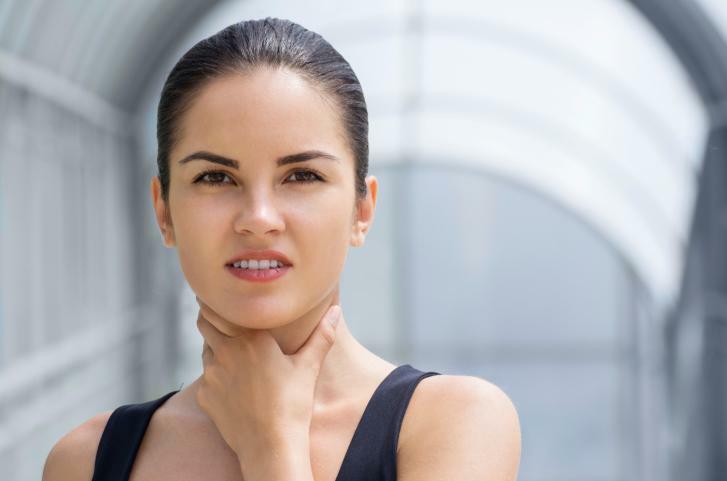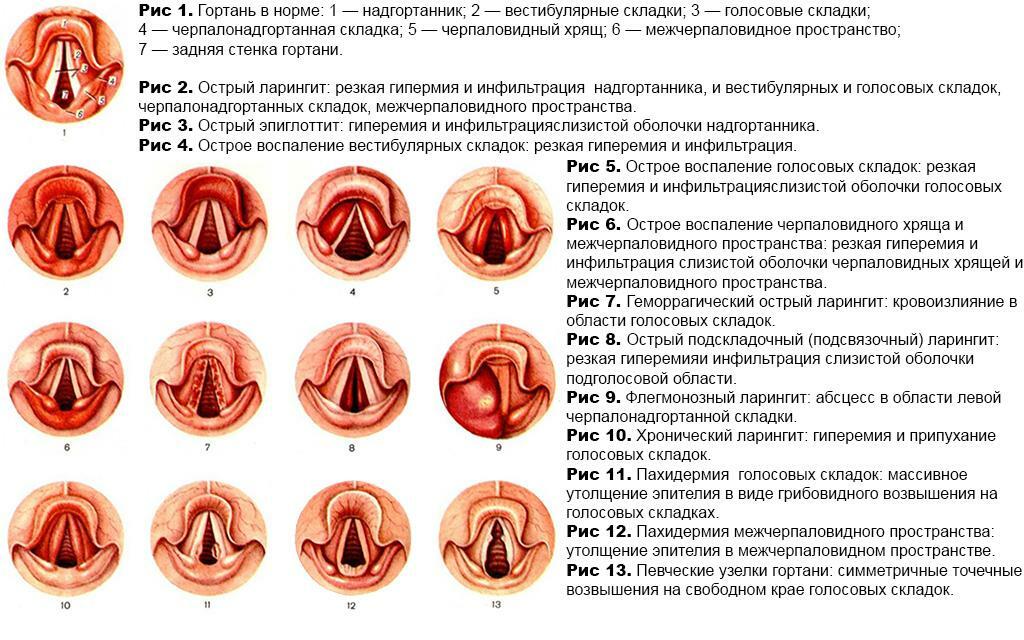The lumbar division includes five vertebrae, disks are located between each vertebra. If the disc becomes damaged, the pathology in the form of a hernia begins to develop. The rupture of the cartilage or fibrous ring is due to a heavy load on the spine. The pathology of the intervertebral hernia is a serious ailment that is accompanied by a strong pain syndrome, difficulty of movement, and in neglected form - a patient's disability.
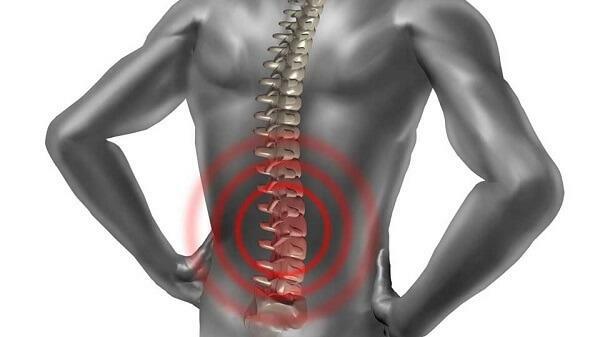
Symptoms of lumbar spine of the lumbar
Content of the material
- 1 Reasons for the development of the pathology
- 2 Symptoms
- 2.1 Video - Intervertebral hernia: symptoms and signs
- 3 How to recognize the lumbar spine
- 4 Preventative measures
- 4.1 Video - Exercises for the lumbar spine
Causes of the pathology development
Intervertebral hernia in the lumbar region arises as a consequence of various causes, among them are:
- trauma of the spine( nCorollary RTA);
- osteochondrosis, which is activated in the lumbar region;
- scoliosis;
- excessive physical load, including in particular the lifting of gravity, if the spine is in the wrong position;
- is obese or overweight;
- dysplasia of TBS;
- tobacco smoking, which leads to a significant deterioration in oxygen supply of blood in the area of intervertebral discs;
- sedentary work( wrong back position);
- problems with metabolic processes.

Schematic representation of the lumbar spine of the lumbar spine
Additional concomitant factors are:
- Lack of physical education.
- Bechterew's disease.
- The risk group is made up of people over the age of thirty( in particular male gender).
- Hereditary factor.
- Permanent, sedentary work without interruptions to warm-up.
- Monotony of movements.
Warning! In addition to smoking, the condition of the cervical and intervertebral discs is adversely affected by coffee consumption and unbalanced diet, as the tissues deteriorate blood supply.
Separately, attention should be paid to the obligatory physical loads that play a big role in the formation of the hernia of the spine. According to the research, it is established that the metabolism after twenty years depends on the motor activity, therefore physical education should be an integral part of the daily routine of the day. Adynamia( a way of life that does not involve physical exertion) accelerates the development of osteochondrosis, and, therefore, brings the likelihood of the formation of an intervertebral hernia.

Stages of formation of the intervertebral hernia
However, physical exertion should be moderate, as excessive weight lifting negatively affects the condition of the spine and leads to an intervertebral hernia.
If an ailment is present, then when the characteristic symptomatology appears, you should find out the main cause of the exacerbation. When the intervertebral hernia is extremely dangerous, sharp movements, inclines forward and quick turns to the side. It is very dangerous to lift the weight in front of you. If the abrupt movement is abrupt, the patient immediately develops a shooting pain( the complication is that the pain syndrome may persist for several years).

Intervertebral hernia
Symptomatology
In general, the lesion of the intervertebral hernia occurs between the fourth and fifth vertebrae. This is explained by the individual peculiarity of the ligaments located in the lumbar region. In addition, the main burden of action falls precisely on this area. The disc between the sacrum and the last vertebra may also suffer.
Attention! People who have a pathology in the form of an oblique pelvis fall into the risk group.
Intervertebral hernia is a pathological condition in which the main symptom is unbearable pain. If the hernia is localized in the area of the last vertebrae, the pain syndrome will be given to the buttocks and to the upper part of the thigh. When the hernia is located between the sacrum and the last vertebra, the pain syndrome can irradiate into the knee and even the ankle.
Pain is characterized by the following indicators:
- initially manifests itself as dull or has a aching character;
- with prolonged tension of the spine, walking, coughing, uncomfortable sitting position begins to grow rapidly;
- accurately determines the point where the pain syndrome is localized;
- pain calms down when the patient takes a horizontal position.
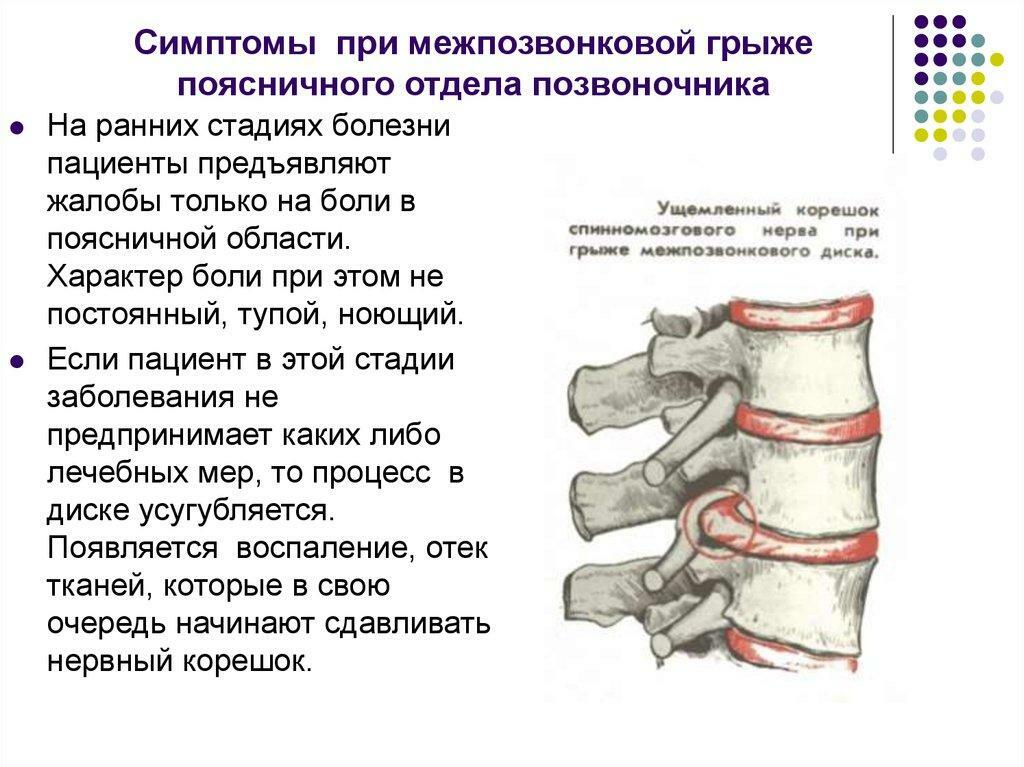
Symptoms of intervertebral hernia of the lumbar spine
Additionally, signs of lumbar hernia include:
- Numbness of the lower extremities.
- There is a feeling of "goose bumps" in the legs.
- The development of lumbling, that is, shooting pain in the lumbar region, which becomes unbearable in any movement.
- Reduction of the motor function of the lower limbs, up to complete paralysis.
- Movement in the lower back becomes stiff.
- With advanced stages of the intervertebral hernia, incontinence and spontaneous defecation may develop.
- Reduction of sexual function.
- The muscle strength of the lower limbs is lost.
- Muscles affected by leg from hernia are significantly reduced, and the skin is dry or accompanied by increased sebaceous glands.
Video - Intervertebral hernia: symptoms and signs
How to recognize a herniated lumbar
| Main feature | Brief description |
|---|---|
| Pain syndrome | Depending on the location of the stiffened root, pain is localized. Over time, the pain can change the location of the location and fall much lower( closer to the hip, lower leg, foot).Most often it can be given to the area of the thumb on the leg. Intensity: the development of an ailment from lumbago begins, and in more complex form is characterized by a painful syndrome of noisy character. The pain intensifies and causes severe discomfort during prolonged walking, incorrect body position when sitting, with sharp turns or inclines, after stresses, which involve increased muscle tension in the back area. The pain can subside when the patient takes a comfortable lying position on the side |
| Limited movements | Consequences in the form of limited movements affect the lower limbs, as the nervous signal of the commands is weakened. It becomes difficult for a patient to lift a leg and bend it in the knee. The person practically can not bend under the even legs, and also make slopes in the sides |
| Weakness of the muscles of the lower extremities | The main consequences fall on the legs, because with the development of the hernia and the lack of proper therapy( drug treatment, exercise therapy, physiotherapy), it is very difficult for the patient to climb alonestairs, crouch, jump. Fainting of the leg muscles can in the worst case result in their complete paralysis |
| Disrupted sensitivity | This symptom is characterized by numbness, burning sensation, decreased sensitivity to hot and cold. Initially, the symptom is localized in the lumbar region, and then it can hit the thigh, the sacral region, the shin. This factor depends on the location of the intervertebral hernia |
| Problems with the functionality of the pelvic organs | The intestines may suffer, resulting in either diarrhea or constipation. If the pathology touched the bladder, then frequent urge to go to the toilet, which can result in incontinence. Men and women have problems with sexual function. If men suffer from a decrease in sexual desire, erectile dysfunction, prostatitis, then women develop gynecological ailments |
| . Visual signs | From the side, you can see that the patient begins to stoop( almost hump), the posture is distorted, and the movements become difficult. On examination, the smoothness of the gluteal fold is diagnosed. |
| Skin discoloration | Complications of the lumbar hernia can affect one of the lower limbs, which will be characterized by its color changes in the skin. That is, the sick leg will be more pale, and the growth of hair on it will deteriorate significantly. It is explained by atrophied muscles |
Attention! If the patient has noticed blanching of the skin on one of the legs due to the development of the intervertebral hernia, it is recommended to feel the pulse regularly on the aching limb in the thigh area, between the index finger and the thumb .
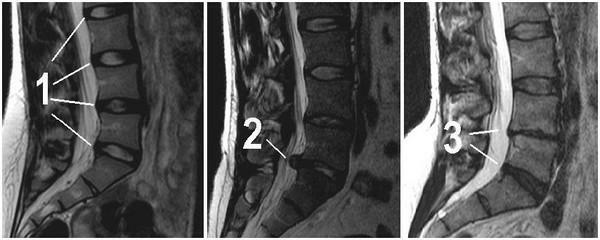
Herniation in the lumbar
Preventative measures
To prevent the development of lumbar hernia it is recommended to follow simple rules:
- Monitor the body weight so that it does not exceed the norm, as obesity contributes to the damage to the intervertebral disc.
- Properly eat and give up bad habits.
- Regularly engage in sports, as a preventive measure may be a daily morning exercise.
- Eliminate possible hypodynamia.
- Monitor the load and do not lift in front of a big gravity.
- If there are prerequisites for the development of pathology, then you need to buy a hard mattress and sleep exclusively on your back.
These rules will help to avoid the development of a serious pathology, which can result in paralysis of the lower limbs. One of the most effective methods of prevention and treatment of the intervertebral hernia in the lumbar region is exercise therapy, it must be used during remission. An example of effective exercises can be seen in the video.


